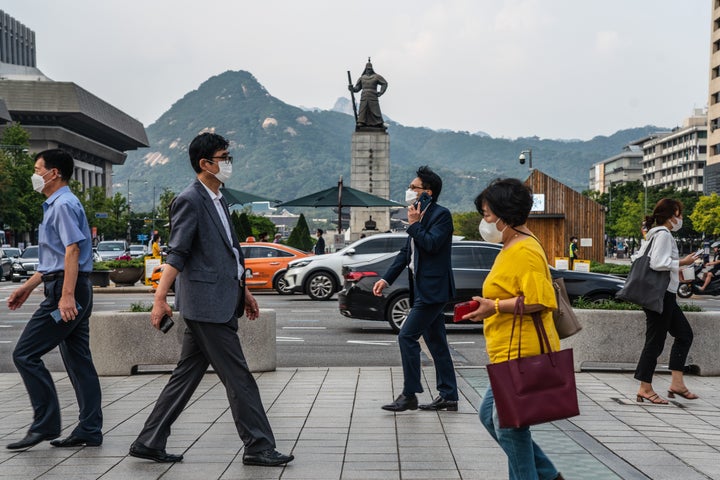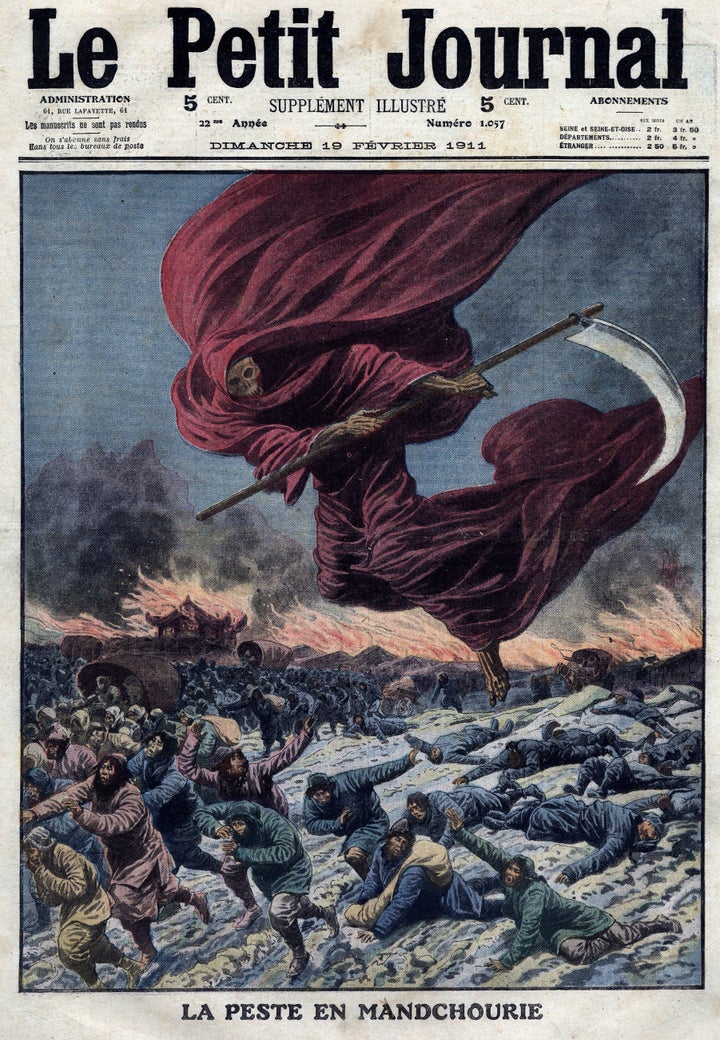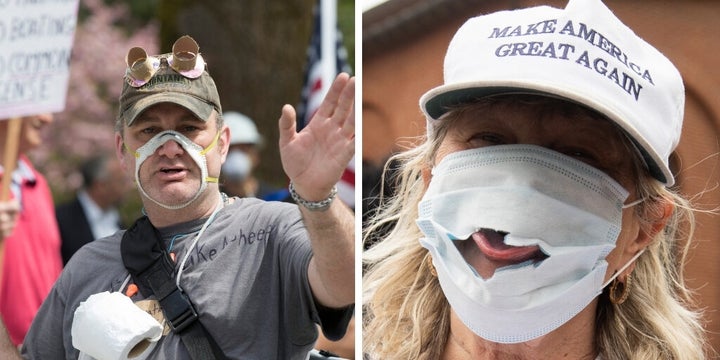Growing up in South Korea, Jamie Cho knew from childhood that if she got sick, she had to put a face mask on, even if it was just a common cold.
“My parents told me it was to keep myself and others safe,” she told HuffPost. “I would see others wear masks as well, especially during the winter seasons.”
The masks weren’t just a medical accessory, she said. For many, they served an aesthetic purpose: something a woman might put on to cover a makeup-less face while running errands or a K-Pop star might slip on to avoid being spotted by fans in an airport.
Cho distinctly remembers that when her family moved to New York, her mom told her that she had to stop wearing masks in public because people would think she was ill or would look at her funny.
“She was scared of me seeming more foreign than I already was at the time as a young immigrant,” the college student said. “Because of that, I’ve never worn a mask in a Western country prior to COVID.”
Masking up is second nature to East Asian immigrants like Cho. But others haven’t taken so easily to the U.S. Centers for Disease Control and Prevention’s recommendation to wear a facial covering. The guidelines have incited a nationwide feud about public health and civil liberties. Some Americans refuse to wear masks, claiming its contrary to their personal freedom. The most strident in the anti-mask movement have called them “unconstitutional,” “autocratic” and “muzzles.”
Meanwhile, in East Asian countries, the majority of the public adapted quickly to mask-wearing (or were already wearing them to begin with) ― something experts believe has contributed to lower COVID-19 death rates.
Naturally, there’s more to the story than masks: Compared to the West, East Asian countries tend to have much lower rates of obesity, a leading risk factor for serious COVID-19 cases. Preliminary studies have also suggested that East Asians may have built up an immunity to the virus, given the history of coronaviruses emerging in East Asia.

But in light of overwhelming evidence supporting the efficacy of facial coverings, it’s probably fair to say the masks helped, too.
Take Hong Kong, for example.
“Because of the custom of wearing masks here, it wasn’t necessary for the government to mandate mask wearing for a long time because the public had already widely adopted their use,” said Ria Sinha, a senior research fellow at the Center for the Humanities and Medicine at the University of Hong Kong. (Sinha is currently directing a COVID-19 archive project.)
There’s a long history of East Asian countries masking up.
Just as the anti-mask movement in America goes back to the 1918-19 flu pandemic (yep, there were protests over government ordinances then, too), so does the East Asian inclination to wear a mask.
In those pandemic years, mask-wearing was widely promoted in Western nations and only then exported to Japan.
“It stayed in Japan, but it disappeared in the West,” said Mitsutoshi Horii, a professor of sociology at the University of Shumei in Japan who’s currently working at its overseas campus at Chaucer College in England. “In Japan, then and now, people are generally concerned with the airborne transmission of the virus, so people wear masks in the hope of reducing the risk of infection.”
Years later, when the flu vaccine had been developed, the Japanese government said it was more important to get the shot than to wear a mask; even so, enthusiastic usage continued in the island country.
In China, the use of face masks against epidemics was practiced even earlier. In 1910 and 1911, citizens were encouraged to wear masks to combat the pneumonic plague outbreak in Manchuria. By the time the plague abated, more than 60,000 people had died in modern-day northeast China, making it one of the world’s largest epidemics at the time.

Still, masks helped the country stave off more deaths. Just as with COVID-19, lockdowns and travel restrictions were implemented to lower the infection rate.
Mask-wearing became de rigueur, too, said Christos Lynteris, a senior lecturer in the department of social anthropology who studies epidemics at the University of St. Andrews in Scotland.
“It was during that outbreak that the mask was adapted for epidemic control purposes and used by doctors, nurses, health staff and the general public for the first time,” Lynteris told HuffPost.
The invention of the anti-epidemic mask was attributed to Dr. Wu Lien-teh, a Cambridge-educated Chinese physician who led anti-plague operations on behalf of China in the region.
According to Lynteris, Wu’s masks were well-received internationally. The public health initiative was covered by the press across the globe, with photographs of mask-wearing plague fighters creating an international sensation.
“After the end of that epidemic, Wu continued as China’s most senior epidemiologist under the newfound republic,” Lynteris said. “He continued to develop the mask, which became a regular epidemic control feature in the country over the next three decades.”
The mask itself became a symbol of medical modernity across East Asian countries, Lynteris said. People don masks in the winter to protect themselves from the flu. They slip one on in the spring to stave off hay fever. The masks also provide protection from air pollution and reduce the spread of germs on crowded and poorly ventilated subways.
There’s an ethical component, too. East Asians wear masks for their own health but principally out of respect for others.
Immigrants in East Asian diaspora communities (including those in the U.S.) often follow suit, in spite of stigmatization from others. (At the beginning of the COVID-19 outbreak, when mask usage was less widespread, many Asian Americans were especially worried that wearing one would draw unnecessary attention to them, given the uptick in xenophobic attacks and discrimination.)
“People responded by wearing masks en masse very early on in the outbreak. Shops were cleaned out, and masks were in short supply. Queues to buy masks were seen across Asia – in Hong Kong, South Korea and Japan, among others.”
- Ria Sinha, a senior research fellow at the University of Hong Kong
Though the history of mask-wearing goes back at least a century, experts say the face mask didn’t reach peak popularity in South Asian countries until the 2002-03 SARS epidemic. Severe acute respiratory syndrome, also a coronavirus disease, lasted about six months as it spread to more than two dozen countries in North America, South America, Europe and Asia before it was stopped in July 2003.
SARS solidified the humble face mask as an everyday staple, Sinha said. When COVID-19 struck, East Asians put on a mask at their own volition.
“The legacy of SARS in 2003 resulted in much faster uptake of mask-wearing for personal protection when COVID-19 appeared,” she said. “It’s a kind of social contract. People responded by wearing masks en masse very early on in the outbreak. Shops were cleaned out, and masks were in short supply. Queues to buy masks were seen across Asia — in Hong Kong, South Korea and Japan, among others.”
Some Americans’ reluctance to wear masks may be tied to championing individualism over collectivism.
In Hong Kong, where COVID-19 cases have remained low, by and large, masks are worn by nearly everyone, without much government urging. According to one study of 1,000 participants, in March, 99% reported wearing face masks when leaving home ― up from 61% in the first survey in January.
Prior to COVID-19, if you didn’t use a face mask in public areas while sick or during the height of the flu season, you’d be at the receiving end of more than a few dirty looks, according to Judy Yuen-man Siu, an associate professor of social sciences at the Hong Kong Polytechnic University. (Siu has tracked the use of mask-wearing in Hong Kong in the aftermath of the SARS outbreak.)
“If you behave against the social norms in Hong Kong by failing to wear a face mask in public areas, you would become a ‘deviant other,’ and thus you might receive dirty looks from the public,” she said.
In an epidemic, not wearing a mask in an East Asian country is seen as “anti-social, irresponsible and dangerous to oneself and to others,” Lynteris said. In Japan, even their fluffy anti-coronavirus mascot, a cat named “Koronon,” dons a mask.
Mask-wearing may have seamlessly blended into everyday life in East Asia because most of the countries have a collectivist bent, Sinha said. People generally prioritize the group over the self. Putting on a face covering when you’re sick or around vulnerable people is part and parcel of good citizenship.
Western societies tend to be more individualistic, stressing the desires of the individual over the needs of the group as a whole.
“A mandate encroaches on my personal freedom; it’s my individual right to not wear one,” an anti-masker might say in response to the CDC’s public health recommendation.
While there’s certainly diversity across East Asia regarding how collectivist societies actually are, “the legacy of disease outbreaks and a more civic-minded community is strong,” Sinha said.
“East Asian countries also have a larger proportion of extended families than Western countries, which means people are more likely to adopt public health measures if they understand it is for their own good,” she added.
The “individual rights” argument against masks has a long history in the U.S. In the 1918 pandemic, there were reports from every city of “mask slackers” failing to comply with the law during the pandemic, leading to their arrests. In San Francisco, an “Anti-Mask League of 1919” was formed.
In 2020, the anti-mask sentiment is alive and well, not in small part because of mixed messaging on masks from officials. It wasn’t just a logistical challenge to secure enough masks; for months, scientists and doctors waffled about the usefulness of face coverings.
Many Western leaders initially side-eyed the mask given the lack of precedent on wearing them. Adopting masks would require a “big adjustment” in our country, Austria’s Chancellor Sebastian Kurz remarked in April, since “masks are alien to our culture.” President Trump finally slipped on a mask in public in July after four months of resisting, but he’s continued to voice his mask skepticism since.

Protests continue, but six months into the pandemic, face masks are seen as “the most powerful public health tool” the nation has against the coronavirus, at least until a vaccine is developed and widely distributed. CDC Director Robert Redfield stressed that message while addressing U.S. lawmakers earlier this week.
“We have clear scientific evidence they work, and they are our best defense,” Redfield said. “I might even go so far as to say that this face mask is more guaranteed to protect me against COVID than when I take a COVID vaccine.”
In other words, Americans might as well get comfortable in masks, since we’ll probably have to wear them in public for the foreseeable future.
It could pay to look on the plus side about masks and take a page from East Asians, Horii said.
“These times could encourage people in the West to reflect upon their own norms and values,” he said. “Rather than asking why people in East Asia are wearing masks, we should ask the people in the West why they did not wear them until recently and why some of them resist it. Japanese people have been doing it for a century!”
Cho, the college student from South Korea, had stopped wearing masks since emigrating to the U.S. She’s more than happy to wear one for as long as she needs to now.
She admits that she looks at the anti-masker movement sometimes and wonders why so many are wasting their energy on the issue.
“Why protest over something that keeps yourself and others safe?” she said. “Masks are not political, and neither are the health and safety of others.”
- Get the latest coronavirus updates here.
- What will life be like once a coronavirus vaccine arrives?
- Everything you need to know about face masks right now.
- What should you still be disinfecting to prevent COVID-19?
- Is it possible you had coronavirus earlier this year?
- Constantly arguing with your partner about coronavirus risks? You are not alone.
Everyone deserves accurate information about COVID-19. Support journalism without a paywall — and keep it free for everyone — by becoming a HuffPost member today.